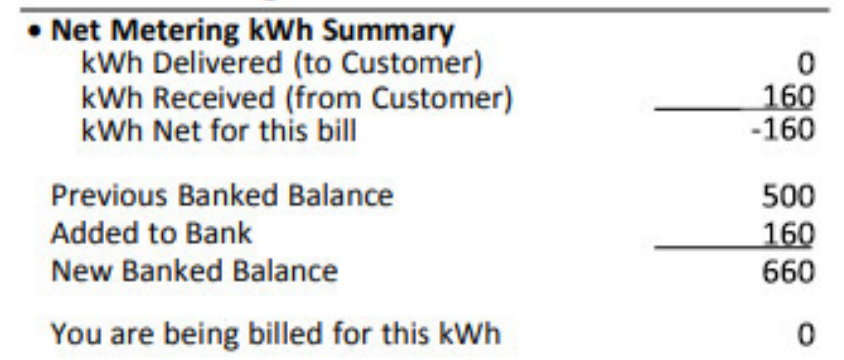Once their solar system is up and running, people frequently wonder why they’re not receiving credit for all the energy it's producing.
The short answer is that going solar can save you money in three ways:
First, by generating electricity to power your home at a substantially lower rate than what you're likely to be paying now.
Second, by locking in that lower rate for the full lifetime of your solar panels, effectively providing a 25-30-year hedge against the steady stream of rate increases that are bound to accrue.
Third, by generating more power than you need during peak sun hours. If your system doesn't include a battery, the surplus solar energy you produce gets sent back into the grid and you're credited for it.
Two numbers you WON'T find on your utility bill
To get the full picture, we'll need to understand four numbers. Importantly, the first two WILL NOT appear on your utility bill:
Energy Produced: This is how much solar energy your panels produced during a billing cycle, regardless of whether it was used to power your home or sent back into the grid.
Energy Consumed: This is the total amount of energy required to power your home during a billing cycle. It doesn’t matter whether it was generated by your solar panels or imported from the grid. Any power you used during the billing cycle, regardless of source, counts toward your consumption.
The reason you won't see either of those on your electric bill is simple—your utility company doesn't even know them.
Your solar panels belong to you
Your solar panels belong to you, not the power company. And that makes the amount of energy they produce nobody's business but yours and especially not theirs.
But losing that information also deprives utilities of the ability to determine how much energy their solar-equipped customers are using.
During any given billing cycle, all they'll know is how much power you bought from them.
But that won't even come close to the total amount of energy consumed by a typical solar-equipped household since all but a small portion of it will be coming from their solar panels.
So while you're going to know the energy produced by your solar system as well as the energy consumed by your household, your utility company won't. Hence, you're not going to find those numbers anywhere on their bill.
Two numbers you WILL find
The next two numbers, on the other hand, will be featured prominently on your electric bill. In fact, once you go solar, they're likely to be pretty much all there is to it.
Energy Delivered (to You): This is the amount of energy you had to draw from the grid during the billing cycle.
If your solar panels produced as much or more energy than you needed, the amount of energy delivered to you will be zero.
If, on the other hand, your solar panels didn't quite manage to meet all your energy needs, the energy delivered to you will be what you consumed minus whatever amount of solar energy you did get from them.
Energy Received (from You): This is how much energy you sent back into the grid during the billing cycle and, hence, the amount you’ll be credited for.
If you wind up using more power than your solar panels produced, your bill will list "Energy Received (from you)" as zero.
If, instead, your panels generated more energy than required, "Energy Received (from you)" will be whatever the surplus was.
An example
Keeping those numbers in mind, let’s take a look at a sample bill.
Suppose during one billing cycle:
You consumed 800 kWh of power.
Whereas your solar panels produced 960 kWh.
Here’s what the bill from Pennsylvania power company, PPL would look like:

This bill can be confusing because it mentions neither the amount of energy your system produced nor the amount you consumed.
But you’ll know that your system produced 960 kWh of power that month. So, it’ll be natural to wonder why on earth you’re only getting credit for 160 kWh.
The reason is that—though your solar panels did indeed produce 960 kWh of energy—800 of them went into powering your home. That means your utility only received the remaining surplus of 160 kWh.
So, that’s what they’re crediting you for.
The upshot
In short, when calculating your monthly solar energy credit, always remember to subtract the amount of solar energy you consumed from the total amount your panels produced.
Doing that should forestall any possible confusion you might have concerning produced vs. exported solar power.